Sometimes opportunity doesn’t just knock; it crashes right through the front door. Take the Southern California adventure trip that is the subject of this story, for example. The Channel Islands and their foreboding cliffs have exerted a longtime attraction for this author and trail runner. And the 1986 Farallon 25 known as Spectre, once a centerpiece of Jeff Elings’ adventurous lifestyle, was now dry-docked on its trailer, sidelined by his recent marriage. He needed the sea, and I needed the islands in them. And so it came to pass that Jeff and his Farallon, and I and my running shoes, fit together like balsamic and vinegar, Bocelli and bocce ball, fishing and fish tales.
But while we were planning our island trek, a third passenger appeared on our list: U.S. Coast Guard Auxiliarist Roy Graboff. Unbeknownst to either Elings or me, Boating had commissioned Roy to join our trip, examining the doings of a pair of typical boaters and offering corrective advice (hard-knuckled as necessary).
At precisely 8:30 a.m. on a Wednesday, Spectre motored up to the visitors’ dock in Channel Islands Harbor. Immediately and with little fanfare, Roy stepped aboard and made his presence, if not his intent, known.
“Where are your dock lines?” Roy barked the moment he saw Jeff’s shoestring-size units. “You need half-inch lines on this boat. These are a joke.”
A longtime boater, and before that a corporate executive, Graboff has a stern countenance that matches his regulation Coast Guard Auxiliary uniform. Boots polished and an inflatable life vest around his neck, he broadcast a no-nonsense image backed up by an all-business demeanor.
Poor Jeff. A mechanical engineer by training and a veteran of seven international boating trips to destinations including the Caribbean, Tonga and Croatia, he expected a guy getaway and instead got Sister Mary Elephant.
“I always use the same dock with its own lines,” Jeff tried to explain, in vain.
And so it began. Our gear was stowed. The cooler stocked. We just wanted to cast off and be gone, but Roy was just starting a transom-to-bow vessel examination while the morning sun grew hotter.
“You need backing plates on your stern cleats,” Roy announced.
For the next 45 minutes he lobbed praise, criticism and warning at Spectre with equanimity. For instance, Spectre’s stuffing box was dripping at a rate of about 120 drops per minute. “Forty drips a minute is OK,” Roy declared. “It shouldn’t be dry because it’ll burn out, but two to three drops per second is too much. Don’t stop it; just slow it down.”
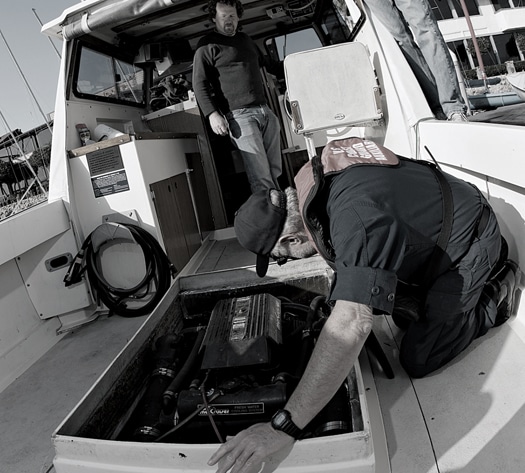
Jeff got busy with a special wrench he keeps aboard for just such fun. And while the engine hatch was open, Roy inspected hoses, fuel lines and the aft bilge pump.
Roy rubbed his beard and studied the electronics array — including Spectre’s outmoded early-model EPIRB, designed to broadcast on 121.5 mhz, a frequency that is no longer monitored by the Coast Guard.
“You can’t use that. It’s useless!” said Roy, explaining that the government changed the frequency to 406 mhz, though aircraft still monitor the older frequency.
“I didn’t know,” Jeff said, remaining calm while this uniformed stranger grilled him. “I never got an e-mail or read any notice about the change.”
Then came the sucker punch. “Please get charts for this boat! And when you do, you should put a dead-reckoning plot on the chart every half-hour to track your position. You’ll need it.” That little directive later relieved Jeff of a crisp c-note at the local chandlery, but he dutifully plotted his course on it while he monitored his chart-plotting GPS.
We still hadn’t left the harbor when Roy the bloodhound turned his attention to safety equipment. “Do you have current flares?” he shot. Jeff showed him a couple aerial, or shooting, flares. “You should have three minimum. Handhelds too. A shooting flare will draw attention from vessels you can’t see, but a handheld will help vessels in view come directly to you.”
Savvy boater that he is, Jeff had stowed a throwable life preserver next to the helm. In fact, it was serving as a cushion for the emergency kicker motor he keeps on board.
“What’s this?” asked Roy, clearly agitated. “Take your throwables out of their protective plastic bags. When critical seconds count, you won’t have time to unwrap one.”
All in all, Roy scoured Spectre for most of an hour before announcing her fit for our trip to Anacapa Island, and he included a welcome vote of respect from the bow. “This is smart to attach the bitter end of your anchor line to the bit — most people don’t,” he said with a smile.
We might have lost our patience on this trip, but not the anchor.
Suitably praised and chastised, Jeff started idling out of the harbor. And then there was Roy. He wasn’t done.
“Did you file a float plan?” he quizzed, seeing puzzled looks all around.
We soon crossed swords again when he announced, “You guys are going to wear life jackets.”
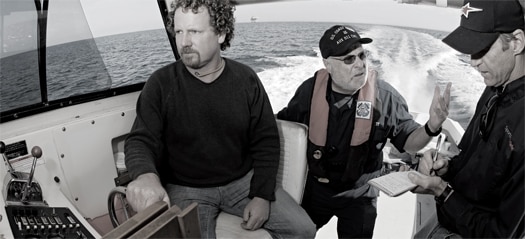
For this author it was like getting a ruler whack on the knuckles. My boating is mostly done in ski boats on inland waters or else on larger ocean vessels, and the truth is that I’ve probably not worn a life jacket since 1968. Knowing this, Roy rattled off some stats — all of them engaging, even if I wasn’t sure of their veracity.
“In 90 percent of drownings, the victims were not wearing life jackets,” Roy began, “and the majority of those people could swim. When you hit cold water, the body’s reflex is to gasp for air, and if you go under, you inhale water instead.”
For his part, Roy wore a neat Type V inflatable collar that seemed vastly less restrictive than the Type I life jackets that Jeff had aboard Spectre. “This one,” Roy said, indicating his vest, “has a mirror, whistle, light, knife and inflator, all integrated.”
As we entered open water, Jeff expertly punched Anacapa’s Arch Rock into the GPS and throttled Spectre to nearly 20 knots. On this clear day, the island was visible on the horizon, and the GPS counted down the 11-mile crossing. Anacapa is part of the five-island, 249,000- acre Channel Islands chain, which was incorporated into the National Park Service in 1980. In other words, it lies captive within a federal bureaucracy — Roy’s domain exactly.
“Did you get permission to land?” Roy queried, his eyes laser-focused.
“Well … no,” I said quietly, perhaps inaudibly. “But I did research it, and the public can visit any time with no permit or cost.”
“OK,” Graboff said with a bit of reluctance.
There’s only one place to land on Anacapa, at aptly named Landing Cove, where a stubby dock cowers beneath a massive rocky cliff inside a tiny hollow. With the currents, swell and wind all playing a part, landing here is like maneuvering a Wallypower in a Jacuzzi. But having owned Spectre for 20 years, Jeff knew all about its quirks.
“What are you doing?” asked Roy, watching Jeff nose in at an angle.
“It’s a fixed-rudder boat,” Jeff explained. “The aft end only goes to starboard in reverse.”
Roy stared at him, his glasses making his eyes look more laser-like. Jeff continued.
“If there’s any wind at all, it’ll hit the cabin and blow the boat around — and there’s always a little wind. To dock, I nose in at an angle under power and then go into reverse to burn off speed. This pulls the back end in, and it also gives me some control, because if you coast in, there’s no control at all.”
Roy remained silent while Jeff expertly coaxed Spectre to the dock, standing with his feet spread for stability as the craft rode the swell up and down.
“Good job,” Roy finally said.
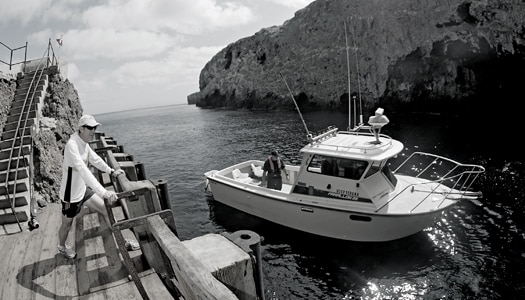
My plan all along was to take a run, on foot, around the island. It started off the dock, with a vertical assault of 200 rusty ladder steps that could be right out of an old Sea Hunt episode. For all I know, they actually were. Aside from a water tower (disguised as a church to keep hooligans from shooting it), a lighthouse and a couple of ranger buildings, there’s precious little man-made on the island, save a 1.5- mile figure-eight loop trail. What the island lacks in length is more than made up for in charm. On the windward side, the relentless breeze tousled and cooled, but the leeward side was still and warm, and a quick look down revealed clear green coves, lush kelp forests and a few fat pinnipeds.
By the time I returned to the boat, Roy had softened — perhaps due to the fact that Spectre had not yet sunk, caught fire or been crippled by a rogue wave. But during lunch he did remind us: “No peeing in the ocean within three miles of shore. That’s the regulation.”
Within an hour of leaving Anacapa, we were safely back at the visitors’ dock, where we assumed our examination was complete. But Roy continued to watch closely as we secured Spectre with her makeshift dock lines, correcting Jeff on his lackadaisical method of dropping the loop over the cleat.
“The problem with that technique is that the boat will pull it so tight in heavy current that you’ll never be able to loosen it,” he opined. Then he demonstrated the proper cleat hitch.
“Thanks for the tip,” said Jeff, clinging to his ever-polite tone.
Then it was time for the moment of truth. I asked Roy for a full report.
“Your extinguisher was up-to-date,” he started. “You had plenty of drinking water on board. You guys were nice and not arrogant.” Then he caught himself. “But in some cases ignorance is even more dangerous than arrogance. You should have sniffed the engine compartment before starting back from the island.”
And then U.S. Coast Guard Auxiliarist Roy Graboff was gone. He shook our hands same as he had hours earlier, swung his shiny boots over the gunwale onto the wooden dock, strode past our undersize dock lines and whisked smartly up the ramp, still wearing his Type V vest with integrated mirror, whistle, light and knife. It looked good. and it was, thankfully, still uninflated.
The X Factors
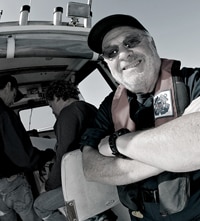
In 2001, Roy graboff, an executive and longtime boater, decided to become a member of the U.S. Coast Guard Auxiliary. As volunteers, Graboff and some 36,000 other USCG auxiliarists have four main jobs:
[1] Conducting safety patrols and pollution checks, helping boaters in distress and assisting the Coast Guard in search-and-rescue operations
[2] Conducting courtesy vessel examinations
[3] Teaching boating safety courses and staffing information booths
[4] Visiting boating stores and distributing boating safety literature
Some auxiliarists work 40 to 50 hours per week and others only a few times per year.
“Technically we cannot do anything but advise the public — we can’t make arrests or board vessels,” Graboff said. “We simply help the public boat more safely, and if we see a blatant situation, we notify the active-duty Coast Guard. We’re like a neighborhood watch.”
We Should Have Had …
Three worst-case scenario must-haves to make any USCG Auxiliarist proud.
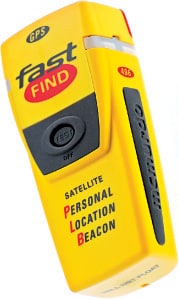
Updated EPIRB
Instead of the analog 121.5 MHz unit, outmoded in early 2009 when the government switched to digital 406 MHz, we should have had a new, GPS-embedded, personal emergency position indicated radio beacon (EPIRB) like the Fast Find ($299, reveresupply.com), or personal locator beacon, like Find Me Spot ($199 includes basic service, findmespot.com). We can now summon help even while treading water.
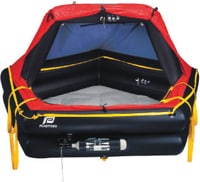
Self-Inflating Raft
With a small inflatable folded on deck, a gas-powered compressor belowdecks and a kicker motor stashed near the helm, Spectre had everything her occupants needed to self-rescue. Unless, of course, a catastrophe left no time to assemble it all. That’s why a self-inflating life raft (from $2,700, westmarine.com) is among our additions. Stock it with flares, food, water and a first-aid kit, and then attach it with a hydrostatic release so it can’t go down with the ship.

Emergency Bung (Plug)
The boat had towels, and the shirts from our backs, in case we needed to stuff a hole in the hull. That’s pretty much the norm. A better solution is the TruPlug ($19.95, truplug.com). It’s a spongy cone (think Nerf) that can be twisted and/or cut to fill a hole to stop water from entering the boat until you can get back to port. Much better than a T-shirt.









